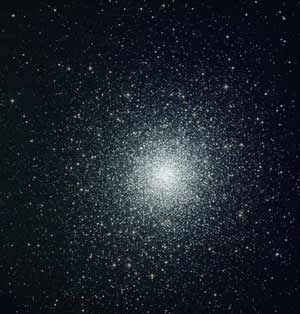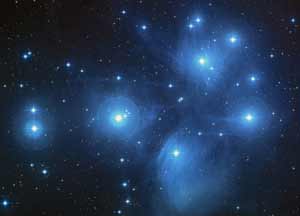Star Clusters What Is A Star Cluster? Star clusters are groups of stars which are gravitationally bound. Two distinct types of star cluster can be distinguished: globular clusters are tight groups of hundreds of thousands of very old stars, while open clusters generally contain less than a few hundred members, and are often very young. Open clusters become disrupted over time by the gravitational influence of giant molecular clouds as they move through the galaxy, but cluster members will continue to move in broadly the same direction through space even though they are no longer gravitationally bound; they are then known as a stellar association, sometimes also referred to as a moving group.
Globular Star Clusters
 Globular clusters are roughly spherical groups of anything between 10,000 and several million stars in a region about 10 to 30 light years across. They generally consist of very old Population II stars, just a few million years younger than the universe itself. The constituent stars tend to be yellow and red, and weigh less than about two solar masses. This is because the hotter, more massive stars have either exploded as supernovae or passed through a planetary nebula phase to become white dwarfs. However, some anomalous blue stars are found in globulars, and are believed to have been formed by stellar mergers in the dense inner regions of the cluster. These stars are known as blue stragglers. Globular clusters are roughly spherical groups of anything between 10,000 and several million stars in a region about 10 to 30 light years across. They generally consist of very old Population II stars, just a few million years younger than the universe itself. The constituent stars tend to be yellow and red, and weigh less than about two solar masses. This is because the hotter, more massive stars have either exploded as supernovae or passed through a planetary nebula phase to become white dwarfs. However, some anomalous blue stars are found in globulars, and are believed to have been formed by stellar mergers in the dense inner regions of the cluster. These stars are known as blue stragglers.
In our galaxy, globular clusters are distributed roughly spherically in the galactic halo, around the galactic centre, orbiting the centre in highly elliptical orbits. In 1917, the astronomer Harlow Shapley was able to estimate the Sun's distance from the galactic centre based on the distribution of globular clusters; previously the Sun's location within the Milky Way was by no means well established.
Until recently, globular clusters were the cause of a great mystery in astronomy, as theories of stellar evolution gave ages for the oldest members of globular clusters that were greater than the estimated age of the universe. However, greatly improved distance measurements to globular clusters using the Hipparcos satellite and increasingly accurate measurements of the Hubble constant resolved the paradox, giving an age for the universe of about 13 billion years and an age for the oldest stars of a few hundred million years less.
Our galaxy has about 150 globular clusters, some of which may have been captured from small galaxies disrupted by the Milky Way, as seems to be the case for the globular cluster M79. Some galaxies are much richer in globulars: the giant elliptical galaxy M87 contains over a thousand.
A few of the brightest globular clusters are visible to the naked eye, with the brightest, Omega Centauri, having been known since antiquity and catalogued as a star before the telescopic age. The best known globular cluster in the northern hemisphere is M13 (modestly called the Great Globular Cluster in Hercules).
Open Star Clusters
 Open clusters are very different to globular clusters. Unlike the spherically-distributed globulars, they are confined to the galactic plane, and are almost always found within spiral arms. They are generally young objects, up to a few tens of millions of years old. They form from H II regions such as the Orion Nebula. Open clusters are very different to globular clusters. Unlike the spherically-distributed globulars, they are confined to the galactic plane, and are almost always found within spiral arms. They are generally young objects, up to a few tens of millions of years old. They form from H II regions such as the Orion Nebula.
Open clusters usually contain up to a few hundred members, within a region up to about 30 light years across. Being much less densely populated than globular clusters, they are much less tightly gravitationally bound, and over time, are disrupted by the gravity of giant molecular clouds and other clusters. Close encounters between cluster members can also result in the ejection of stars, a process known as 'evaporation'.
The most prominent open clusters are the Pleiades and Hyades in Taurus. The Double Cluster of h+Chi Persei can also be prominent under dark skies. Open clusters are often dominated by hot young blue stars, because although such stars are short-lived in stellar terms, only lasting a few tens of millions of years, open clusters tend to have dispersed before these stars die.
Once an open cluster has become gravitationally unbound, the constituent stars will continue to move on similar paths through space. The group is then known as a stellar association, or a moving group. Several of the brightest stars in Ursa Major are members of a former open cluster, and have similar proper motions. Other bright stars across the sky, including Sirius and Alpha Ophiuchi, seem to also be related to this group. Our Sun lies within this stream of stars at the moment, but isn't a true member as shown by its different galactic orbit. Another stellar association is that surrounding Mirfak (α Persei), which is very prominent in binoculars. Distant moving clusters can't readily be detected since the proper motions of the stars need to be known.
** Information provided by Wikipedia, the free online encyclopedia. **
Permission is granted to copy, distribute and/or modify this document
under the terms of the GNU Free Documentation License, Version 1.2
or any later version published by the Free Software Foundation;
with no Invariant Sections, no Front-Cover Texts, and no Back-Cover Texts.
A copy of the license is included in the section entitled "GNU
Free Documentation License". |